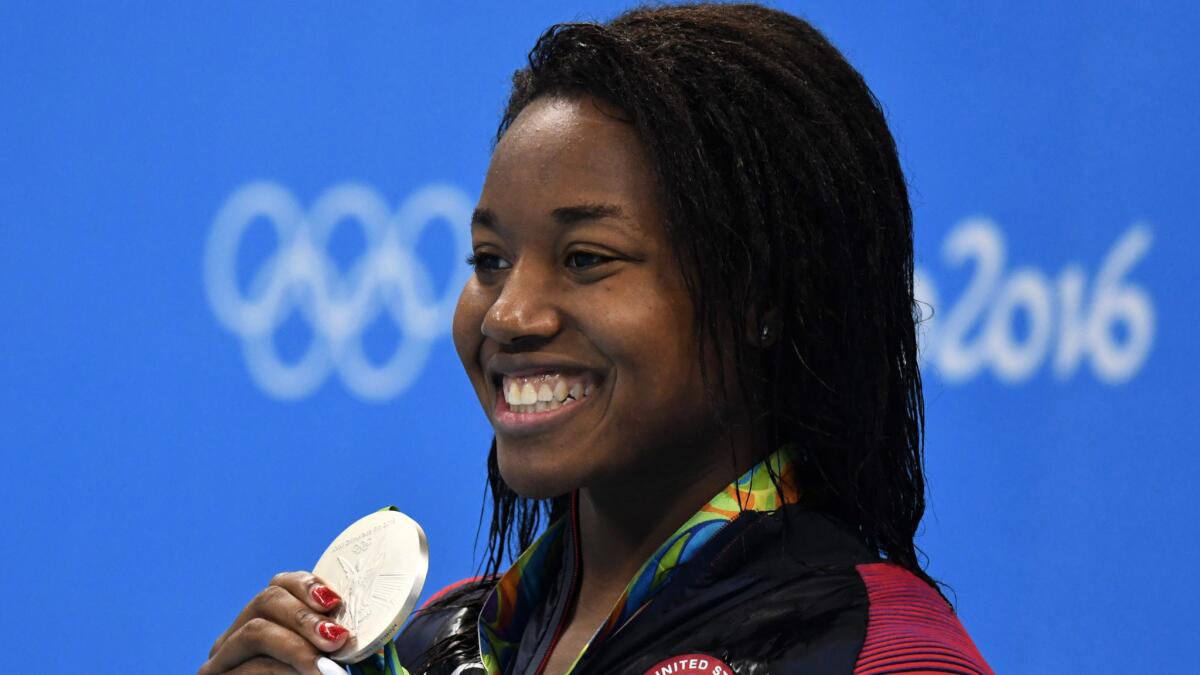Op-Ed: An unspoken barrier to getting more black girls in the pool: the hair factor

- Share via
Olympian Simone Manuel’s first-place finish in the 100-meter freestyle last week was more than a personal accomplishment: It was a cultural milestone. When she finished the race in 52.7 seconds, an Olympic record, she became the first African American woman to win an individual gold medal in swimming.
Her victory thrilled the whole country even as it put an uncomfortable spotlight on the lack of diversity in the world of competitive swimming. The problem starts with a limited pipeline. Seventy percent of African American children can’t swim, resulting in this tragic statistic: Black children drown at a rate three times higher than whites.
For the record:
7:59 a.m. Feb. 22, 2025This article originally stated that Simone Manuel was the first African American to win an individual gold medal in swimming. She was the first African American woman to do so.
Geography, race, access and poverty all are contributing factors. But for black girls, there’s another unspoken barrier: the hair factor.
Even at 6, I was smart enough to figure that out that if my hair wasn’t good, it must be bad. Misbehaving hair.
Throughout American history, the texture and length of our hair has been used, along with skin color, as a barometer, both within and outside of the black community, in defining the very essence of beauty.
From an early age, black girls receive all sorts of subtle and direct messages about where they rank on that hair barometer, and come to understand that the elements — water, wind, heat — are obstacles to meeting white standards.
My epiphany came when I was 6. I was playing outside in a warm Virginia summer rain when my mother appeared on the front porch and shouted: “Girl, you better get your butt inside. You must think you have good hair or something.”
Even at 6, I was smart enough to figure that out that if my hair wasn’t good, it must be bad. Misbehaving hair.
I was one of five sisters, so my young mother had her hands full. I have vivid memories of waiting my turn in the kitchen for Mom to tame my nappy hair. It felt as though she were going to war, armed with a stiff brush, a jar of Vaseline to grease down the edges and her strong hands, which pulled my head back so hard, it brought tears to my eyes as she braided three tightly woven plaits. Every night she tied our hair down with rags with the hope that everything would stay in place for a couple of days before she went into battle again.
For special occasions such as Easter, Christmas or the first day of school, Mom would splurge and take us to the hairdresser to get our hair professionally straightened with a hot comb.
On the days leading up to the hairdresser, we could let loose: run, sweat, even frolic through my Grandma Ada’s backyard sprinkler. Post hairdresser, there was a moratorium on sweating and water contact of any kind to the hair. Swimming, assuming a pool was available, was certainly off limits.
Once, after just getting my hair pressed, I was taking a bath at my grandmother’s house and turned on the shower by mistake. My finely straightened hair quickly became a mini Afro. Mom was furious and punished me by canceling my overnight with Grandma so she could work on straightening my hair before the start of school on Monday.
In the black community, hair management is serious business. My mother worried that if she let her daughters leave the house with unkempt hair, the neighbors would whisper.
So, during my freshman year in high school, when the swim team coach offered to teach me how to swim and introduce me to competitive swimming, my mother nixed the idea.
“And what about your hair?” she asked. “Is he going to pay to get your hair done every week?”
At the time, given my own hair insecurities, I thought Mom’s concern was a reasonable one, so I politely turned down the offer.
The hair thang is so embedded in the black community that when my daughter was born, my mother sat me down and reminded me that given my lack of hair-management skills, I needed to up my game and learn how to take control of my little Casey’s locks. The implication was clear: I had a family reputation to uphold.
My mom was right about my lack of skills. But, thankfully, I married a guy who could braid with compassion. So, along with Casey’s babysitter, and her aunts who occasionally pitched in, I managed to get her through childhood without disgracing the family.
Although I worried about my daughter’s hair way too much, especially when visiting with my mom and other family members, I was determined to break with one ill-advised family tradition. I made sure that Casey and her older brother, Ryan, learned how to swim at an early age.
One day, after I had just struggled to braid Casey’s hair, she asked if she could go swimming with a friend’s family. When she returned home, her hair was wild and frizzy, all my braiding undone.
“Mom!” she yelled. “I had the best day ever!”
I took a deep breath, stroked her still wet hair and gave her a big hug.
Judy Belk is a writer based in Los Angeles. She is president and chief executive of the California Wellness Foundation.
Follow the Opinion section on Twitter @latimesopinion or Facebook.
MORE OP-EDS:
How using Ebonics affects black Americans
Sick and tired of hearing that Hillary Clinton is sick and tired
More to Read
A cure for the common opinion
Get thought-provoking perspectives with our weekly newsletter.
You may occasionally receive promotional content from the Los Angeles Times.










